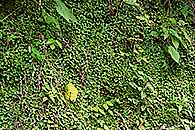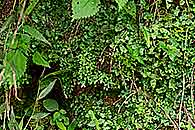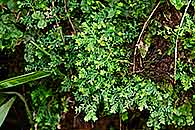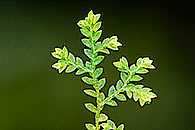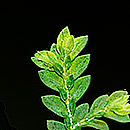Selaginella tenerrima A. Braun ex Kuhn
Synonyms |
Stachygynandrum tenerrimum (A. Braun ex Kuhn) Carruth. |
|---|---|
Common name |
|
Description |
Plant small, erect or subprostrate, branched from the base, 2–8 cm high, rarely taller with 2–3 main stems; stem soft, flexuous, loosely branched, rooting from axils of lower branches, outline of system ovate. Leaves dimorphic; median leaves lanceolate-elliptic in outline, margins slightly toothed, base truncate, apex gradually tapering into a fine setose point, the bristle-like point equalling the limb and often bent outwards, 1.25–1.75 x 0.25–0.4 mm; lateral leaves ovate-elliptic in outline, margins toothed, apex obtuse or rounded, base unequal, that on the acroscopic side enlarged, 1.25–1.5 x 0.75 mm. Strobilus 3–4 mm long, at the tips of branches, maturing ± simultaneously, with male sporangia only at tips; sporophylls of 2 kinds, similar to, but narrower than their respective leaves and more spiny on margins; dorsal: green, ovate-lanceolate, pointed at the apex, serrulate, keeled; ventral: broadly ovate-lanceolate, long acuminate at apex, ciliae. |
Notes | This species is small (< 10 cm) without filiform runners, has dimorphic leaves, stems that are ± erect and branched from the base, margins ciliate-dentate. |
Derivation | tenuis: thin, fine, very delicate, referring to the small size of this species. |
Habitat | In various types of seasonally moist & shady places: bare soil on steep rocky slope in evergreen riverside forest; bed of intermittent rivulet; under boulders on bare sand on seasonally flooded river bank; vertical rocks covered with mosses. |
Distribution worldwide | See African distribution. |
Distribution in Africa |
Angola, Burundi, Cameroon, Central African Republic, Dem. Republic of Congo, Ethiopia, Gabon, Guinea, Mali, Mozambique, Nigeria, Rwanda, Sudan and South Sudan, Tanzania , Uganda, Zambia. |
Growth form |
Lithophytic, terrestrial. |
Literature |
|
